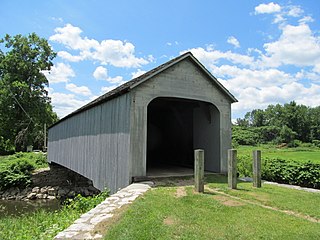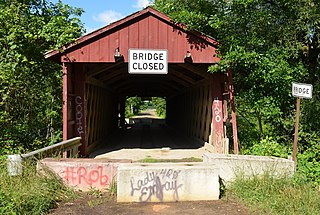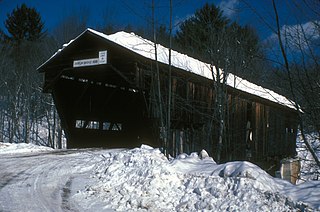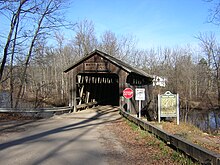
A covered bridge is a timber-truss bridge with a roof, decking, and siding, which in most covered bridges create an almost complete enclosure. The purpose of the covering is to protect the wooden structural members from the weather. Uncovered wooden bridges typically have a lifespan of only 20 years because of the effects of rain and sun, but a covered bridge could last over 100 years. Once common, only about one in 10 survived the 20th century. The relatively small number of surviving bridges is due to deliberate replacement, neglect, and the high cost of restoration.

The Flat River is a tributary of the Grand River in the western part of the U.S. state of Michigan. It rises as the outflow of First Lake, the last in a chain of geographically close, connected lakes known as Six Lakes in Belvidere Township, west of Edmore in Montcalm County. It flows mostly south and slightly west through Montcalm County, Ionia County, and Kent County, flowing into the Grand River in Lowell. Other cities it flows through along the way include Greenville and Belding.

A truss bridge is a bridge whose load-bearing superstructure is composed of a truss, a structure of connected elements, usually forming triangular units. The connected elements may be stressed from tension, compression, or sometimes both in response to dynamic loads. The basic types of truss bridges shown in this article have simple designs which could be easily analyzed by 19th and early 20th-century engineers. A truss bridge is economical to construct because it uses materials efficiently.

The Bollinger Mill State Historic Site is a state-owned property preserving a mill and covered bridge that pre-date the American Civil War in Burfordville, Cape Girardeau County, Missouri. The park was established in 1967 and offers mill tours and picnicking. It is managed by the Missouri Department of Natural Resources. It includes the Burfordville Covered Bridge, which is listed on the National Register of Historic Places.

The Ada Covered Bridge is a 125-foot (38 m) span Brown truss covered bridge erected in 1867 in Ada, Michigan, United States. Carrying Bronson Street across the Thornapple River, it is located just south of where the Thornapple enters the Grand River, in turn just south of M-21. It is listed on the National Register of Historic Places.

Fallasburg Bridge is a 100-foot (30 m) span Brown truss covered bridge, erected in 1871 in Vergennes Township, Michigan, United States, 5 miles (8.0 km) north of Lowell on the Flat River. Carrying Covered Bridge Road across the Flat, it is located in the Fallasburg Historical District south of Whites Bridge and Smyrna. It is listed on the National Register of Historic Places, and along with Whites Bridge, Langley Covered Bridge, and Zehnder's Holz Brucke, is one of only four Michigan covered bridges open to vehicle traffic.
A Brown truss is a type of bridge truss, used in covered bridges. It is noted for its economical use of materials and is named after the inventor, Josiah Brown Jr., of Buffalo, New York, who patented it July 7, 1857, as US patent 17,722.

The Grant Mills Bridge, officially the Millbrook Bridge, is a wooden covered bridge over Mill Brook in Hardenburgh, New York, United States. It is one of 29 covered bridges in the state.

The Old Covered Bridge, also known as the Upper Sheffield Covered Bridge, is a covered bridge on Covered Bridge Lane in Sheffield, Massachusetts. It is a replica of an 1837 lattice truss bridge that was destroyed by fire in 1994. At the time of its destruction it was the oldest covered bridge in Massachusetts. The bridge was listed on the National Register of Historic Places in 1978. The bridge is open to pedestrians.

The Waterford Covered Bridge is a Town lattice truss covered bridge spanning LeBoeuf Creek in Waterford Township, Erie County in the U.S. state of Pennsylvania. The bridge was built in 1875, and is 85 feet 11 inches (26.2 m) in length. The Waterford Covered Bridge is one of two remaining covered bridges in Erie County, along with the Harrington Covered Bridge. The bridge is also the only Town lattice truss bridge in the county and one of only 19 in Pennsylvania. It was documented by the Historic American Buildings Survey in 1936 and was listed on the National Register of Historic Places in 1980. In 2011, the bridge was closed due to its deteriorating condition.

The Covered Bridge in Cedarburg, Ozaukee County, Wisconsin, United States, is one of the last remaining covered bridges in that state, which once had about 40 covered bridges. Built in 1876 to cross Cedar Creek, the bridge is 120 feet (37 m) long and is made of pine with oak lattices. It was listed on the National Register of Historic Places in 1973 and is now used only for pedestrian traffic.

The Delhi Bridge, also known as the East Delhi Bridge, is a one-lane, wrought iron Pratt through truss bridge that carries East Delhi Road over the Huron River in Washtenaw County, Michigan. The bridge was completed October 12, 1883 to replace a wooden span built in 1851. In 1917, the bridge was severely damaged by a tornado but was rebuilt. After it was closed to traffic in 2005 for being unsafe, the bridge was renovated and reopened in 2009. The bridge is listed on the National Register of Historic Places.

The Durgin Bridge is a covered bridge carrying Durgin Bridge Road over the Cold River in eastern Sandwich, New Hampshire. Built in 1869, it is a rare surviving example of a Paddleford truss bridge, and one of the few surviving 19th-century covered bridges in New Hampshire. It was listed on the National Register of Historic Places in 1983.

Babb's Bridge is a covered bridge spanning the Presumpscot River on Hurricane Road, between the towns of Gorham and Windham in Cumberland County, Maine. Built in 1976, it is a replica of a 19th-century bridge that stood on the site until destroyed by fire in 1973. The 1973 bridge was listed on the National Register of Historic Places in 1972.

The Hall Covered Bridge, located in southern Rockingham, Vermont, carries Hall Bridge Road across the Saxtons River, just north of its junction with Vermont Route 121. It is a Town lattice truss bridge, built in 1982 as a replica of a circa-1867 bridge that was destroyed by an overweight truck in 1980. The bridge was listed on the National Register of Historic Places in 1973.

The Grist Mill Bridge, Dam and Mill Site consists of three structures located along Upton Road between Island Road and the Maple River, one-half mile west of Elsie, Michigan in Duplain Township. The three structures are:

The Orne Covered Bridge is a replica of a historic bridge on Back Coventry Road in Irasburg, Vermont. Built in 2000, it is a replacement for a 19th-century bridge which stood on the site until it was destroyed by arson in 1997. The historic bridge was listed on the National Register of Historic Places in 1974.

The Martin Road Bridge is a former road bridge which carried Martin Road across the Shiawassee River in Caledonia Township near Corunna. It was one of the oldest metal through truss highway bridges in Michigan, and was listed on the National Register of Historic Places in 1991. As of 2016, the bridge has been removed from its original site, and will be restored and reassembled at the Auburn Heights Preserve in Yorklyn, Delaware.























